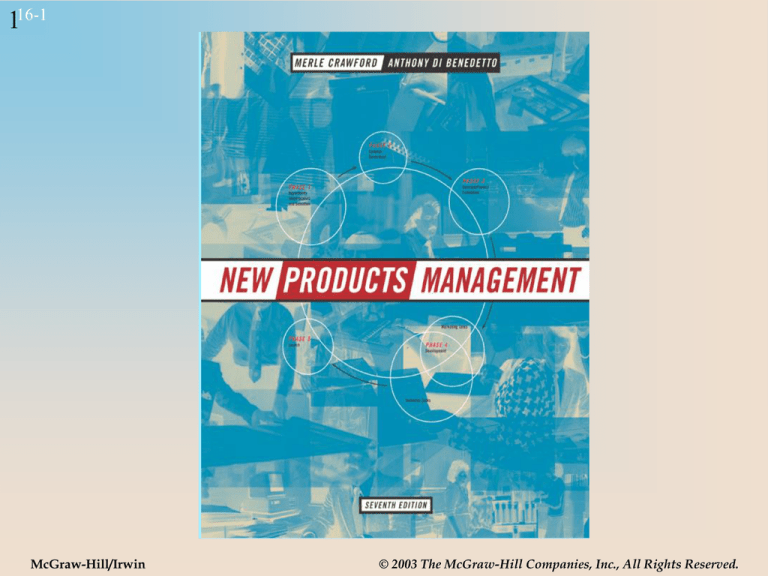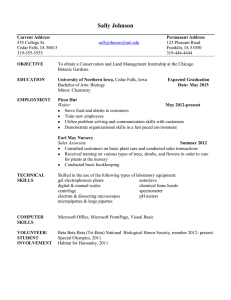
116-1
McGraw-Hill/Irwin
© 2003 The McGraw-Hill Companies, Inc., All Rights Reserved.
216-2
CHAPTER SIXTEEN
PRODUCT USE TESTING
316-3
What is Product Use Testing?
Product use under normal operating conditions.
--------------------------------------------------------Some terms:
– Alpha testing: done in-house.
– Beta testing: done at the customer site.
Typical goals of beta testing: to determine if the
product works and is free of “bugs.”
416-4
Arguments Against Product Use Testing
•
•
•
•
•
•
A fortune has already been spent on the product.
Market research says the product is a winner.
Competitor is working on a similar product.
May suggest (to management) lack of faith in product.
Customers have to learn how to use the product.
Competitor may steal our idea and beat us to the
market.
------------------------------------------------------------------• Experience: “We KNOW it works!”
• Momentum: “It’s too late to change it now!”
516-5
One Argument For Product Use Testing:
Dry Idea Deodorant
Figure 16.1
• Process was anything but linear.
• Gillette discovered flaws in product design through
in-house “alpha testing” and beta testing with users.
• Gillette got some surprises in terms of benefits sought
-- “back to the drawing board” near end of process!
(Luckily, quick fix was available.)
616-6
Arguments For Product Use Testing
• Better to build off a technology base that provides
some insulation from competitive copying than to
worry about such copying.
• Customer needs are complex sets -- use testing would
have identified problems with GTE Airfone, Apple
Newton, P&G Olestra.
• Delivering a total quality product -- avoiding "horror
stories" of poor product quality before product is
marketed.
716-7
Inadequate Use Testing:
NCR's Warehouse Manager
• Beta tests concluded before key bugs showed up.
• Did not thoroughly test a part of the package licensed
from another firm.
• Continued selling and installing even after problems
surfaced and sales were officially halted.
• Promised single source solutions though were relying
on their licensee for servicing their part of the package.
• Told individual customers that they must have caused
the problem.
Needless to say, even just the lawsuits far outweighed the savings
earned from cutting product use testing.
816-8
Knowledge Gained From Product Use
Testing
Figure 16.4
•
•
•
•
Pre-use sense reactions.
Early use experiences ("Does it work?").
Major benefits results (beta tests).
Diagnostic information.
916-9
Common Pitfalls of
Beta Testing
Figure 16.5
• Beta test site firm has no internal capacity to test the performance of the
product at the required level and lacks the funding to hire an outside firm to
do the test.
• Developer puts in a wishy-washy performance requirement like "userfriendly" which is meaningless without a measurable specification.
• Testing is done too late in the NPD process, which almost ensures that
development time will be extended and production delays will occur. Doing
testing in increments throughout the process can avoid this pitfall.
• Developers attempt to beta-test their own products. By definition they are
too close to the product to critically test it and find problems.
• Developers ignore early negative results, hoping that the product will
improve by itself during the NPD process. All beta test results, whether
positive or negative, need to be honestly evaluated.
16-10
10
Gamma Testing
• Beta testing may not meet all the product
developer’s requirements.
– Does the new product meet customers’ needs?
– Is it cost-effective for them?
• Gamma testing involves thorough use and
evaluation of the new product by the end user.
• It’s an ideal product use test -- but in many
cases firms go with beta testing.
– Cost and time considerations
– Keeping ahead of competitors
16-11
11
Some Key Testing Dimensions
• User groups to contact (lab personnel, experts, employees,
stakeholders).
• Mode of contact (mail vs. personal, individual vs. group, point
of use vs. central location).
• Identity disclosure (avoid halo-image effects).
• Degree of use explanation (no comment, some, full
explanation).
• Degree of control over use (supervised vs. unsupervised)
• Singularity (monadic usually less sensitive than paired or
triangular comparison).
16-12
12
More Key Testing Dimensions
•
•
•
•
Duration of use (single use vs. extended periods).
Source of product (batch, pilot plant, final production).
Product form (single product vs. variants).
Mode of recording reaction (like/dislike, preference,
descriptive information).
• Source of norms (past experience, market research firms).
• Research service (internal vs. outside personnel).
16-13
13
Types of Product Use Tests
Figure 16.6
Type
Products
Instructions
Monadic
The new product alone.
"Try this new
toothbrush, and tell me
how you like it."
Paired comparison
The new product and
"Try these, and tell me
another one: the market
how you like them and
leader, the leader in a
which you prefer."
key segment, the "best."
Triangular
The new product and
two others, or two
variants of the new
product and one other.
Same as above.
Multiple-product techniques can use side-by-side or staggered (sequential
monadic) product-use approaches.
16-14
14
Data Formats: Like/Dislike
Figure 16.7
16-15
15
Data Formats:
Preference and Descriptive
Figure 16.7
(cont.)




